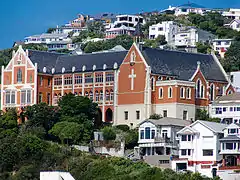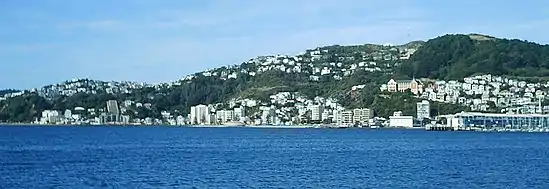St Gerard's Church and Monastery
St Gerard's Church and Monastery collectively form one of Wellington's most distinctive and iconic landmarks. Located on Mount Victoria in Wellington, both buildings are classified as "Category I" ("places of 'special or outstanding historical or cultural heritage significance or value'") historic places by the New Zealand Historic Places Trust.[1][2] They are built on the site of a sixteen-roomed house (called Fitzgerald's Folly) and property owned by James Edward Fitzgerald who some claim to be New Zealand's first Prime Minister.
| St Gerard's Church and Monastery | |
|---|---|
 St Gerard's Church and Monastery in 2008 | |

| |
| General information | |
| Architectural style | Gothic |
| Town or city | 73-75 Hawker Street, Mount Victoria, Wellington |
| Country | New Zealand |
| Coordinates | 41.291962°S 174.790784°E |
| Construction started | Church: 1908, Monastery: 1931 |
| Design and construction | |
| Architect | Church: John Sydney Swan; Monastery: Frederick de Jersey Clere |
| Designated | 5 April 1984 |
| Reference no. | 226 and 227 |
The Church
The church was built in 1908, to the design of John Swan, for the Congregation of the Most Holy Redeemer, known as Redemptorists, a religious institute of priests and brothers. The church was the first in the world to be dedicated to the Italian member of their order and saint, Gerard Majella, after his canonisation.[2] It is constructed to a simple gothic design built of brick, accommodating about 200 people. The church is noted for its assemblage of fine stained glass windows produced by Hardman and Son of Birmingham,[3] "rated by the company the best they had ever exported."[4] Swan designed the fine marble altar made of green Devonshire marble with supporting columns of green Galway marble, and throne and white steps of white Carrara marble. A panel of Italian mosaics depicting the Annunciation adorns the altar front.[4]
St Gerard
As the first church in the world dedicated to Gerard Majella, the church was the location for an oil painting of St Gerard in Ecstasy which was given by Pope Pius X to the Wellington church in recognition of that status. The work was painted in Rome by Giovanni Gagliardi[5] for the saint's beatification in 1893. In 1904, for the canonisation, the painting was carried through Rome in procession and hung in St Peter's.[3]
The Monastery

Completed in 1932, funded by public donations, the three storied Monastery was constructed as a home for the Redemptorists.[1] The foundation stone was laid by Archbishop Redwood and it was blessed and opened on 10 April 1932 by Archbishop O'Shea (who was coadjutor bishop at that time).[3] Frederick de Jersey Clere is usually regarded as the architect for the monastery in succession to, or in collaboration with his architectural practice partner, John Swan.[3] The structure is of reinforced concrete with brick in-fill panels, Gothic windows and red-brick arches for the cloisters which are situated to benefit from the northern sun.[6]
The Redemptorists

The Redemptorists first arrived in Wellington in 1882 and were based in the Fitzgerald house from 1908 until its replacement by the monastery building in 1932.[5] For 56 years from 1932 to 1988, St Gerard's Monastery was the centre of their mission in New Zealand. This consisted of the preaching of parish retreats and missions all around the country and they presented devotional activities at St Gerard's itself such as frequent and regular novenas, rosary and other devotions. The Redemptorists also had the Holy Family Confraternity for men and the Confraternity of Our Lady of Perpetual Succour for women.[7] "A well-patronised service was an undertaking always to have a priest available for anonymous confession or spiritual consultation at the press of a special doorbell."[5] The monastery had an outstanding choir which was heard on radio in a series of services beginning in October 1927. Gradually the sermon took precedence over the music and this attracted more listeners, many of them non-Catholics.[5]
In 1988, because of the costs associated with the buildings and their own declining numbers, the Redemptorists decided to sell the buildings, they took the great St Gerard painting with them.[8]
Institute for World Evangelisation
The complex was acquired in 1992 by the Institute for World Evangelisation - ICPE Mission, a Catholic association of the faithful, for use as a retreat and training centre for Catholic evangelist missionaries operated by a resident community. However, the church's public worship role continues with a Mass celebrated by the Institute's priests every Sunday at 10.30pm.[9] The prominent and dominant position of the monastery has been preserved by the Wellington City Council acquiring property between the monastery and the cliff over Oriental Bay to prevent the buildings being obscured from view from almost any vantage point around Wellington Harbour.[9]

See also
| Wikimedia Commons has media related to St Gerard's Church and Monastery. |
Notes
- "St Gerard's Monastery". Register of Historic Places. Heritage New Zealand. Retrieved 25 May 2010.
- "St Gerard's Church". Register of Historic Places. Heritage New Zealand. Retrieved 25 May 2010.
- Fearnley 1977, pp. 151–153.
- McGill 1997, p. 147.
- O'Meeghan 2003, pp. 180–181.
- McGill 1997, pp. 147-149.
- Jack Duggan, St Joseph's Parish, Te Aro and Mount Victoria, 1885-2007: A Perspective on Our Parish History and Catholic Faith, St Joseph's Parish, Mount Victoria, 2007, p. 237
- St Gerard's Monastery website (retrieved 11 April 2018)
- ICPE Mission New Zealand (retrieved 11 April 2018)
References
- Fearnley, Charles (1977). "St Gerard's Church and Monastery, Catholic". Early Wellington Churches. Wellington: Millwood Press.CS1 maint: ref=harv (link)
- McGill, David (1997). Landmarks: Notable Historic Buildings of New Zealand. Godwit and Historic Places Trust.CS1 maint: ref=harv (link) (photographs by Grant Sheehan)
- O'Meeghan, Michael (2003). Steadfast in hope: The Story of the Catholic Archdiocese of Wellington 1850-2000. Catholic Archdiocese of Wellington.CS1 maint: ref=harv (link)
